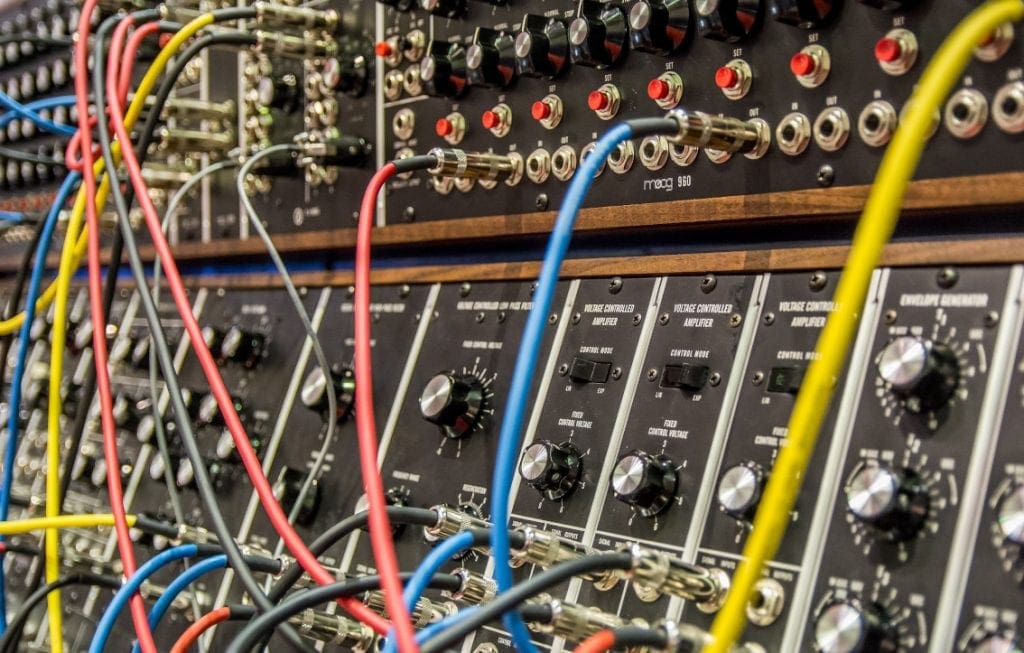Shopping for Synthesizers: A Beginner’s Guide


Without synthesizers, would industrial music exist? Claus Larsen of Leaether Strip bought his first Moog in 1982; once he learned to make sounds with it, he started writing songs. Ministry emerged from the hopeless ether of non-existence as a synth-pop band. And can you picture Skinny Puppy without Dwayne Goettel, cEvin Key, or Mark Walk? Perish the bloody thought.
If your band needs a healthy dose of synth magic, choose wisely. Here’s a short list of some of the better options:
Roland JD-Xi
The Roland JD-Xi falls squarely at the top of this list, mainly because it comes across as a jack-of-all-trades. It is small but versatile. New, it will set you back around $500, but sometimes you can pick up used models at Guitar Center or eBay.
The Roland JD-Xi produces sounds that do not sound extensively digital or over-processed. It also features a built-in sequencer and an arpeggiator, allowing you to playback and record different tracks in real-time.
An exciting feature with the Roland JD-Xi is the inclusion of the hybrid analog synth. Beginners can find this synthesizer intriguing as it will help them discover the sounds that they love best.
Korg microKORG
This is another excellent entry-level synth. It’s a little cheaper than the Roland new, and you might be able to find even cheaper used systems online. The MicroKORG is a portable and flexible synthesizer with seven central knobs allowing you to access the critical functions. It has a modulation wheel, a pitch wheel, and buttons to access the synthesizer’s features.
This synthesizer comes with four polyphony notes, which is useful if you are not planning to use massive chords. It also contains stereo left/right outs, MIDI THRU/OUT/IN for connecting other useful gears, and a dynamic microphones and condenser section.
The microKORG also comes with two digital oscillators with seven waveforms, a VOCODER, and DWGS waves. It also has 128 savable patch memory, though it does not have a sequencer or a means for looping phrases.
Moog Sub Phatty
The Moog Sub Phatty is significantly more expensive than the first two entries on this list. At the time of this writing, it retails closer to $850. While it’s expensive, Daniel Fisher calls it “a beast.” The Phatty comes with 25 keys and is entirely analog. It can produce only a single note at a time. Even though this synthesizer is monophonic, it has a sturdy build and has excellent basses and leads.
The synthesizer has an excellent finish and quality with a convenient size if you plan to carry it around. The layout is simple, with knobs that are responsive and easy when being turned.
It does not have a menu or screen to preview any settings, though the keys, knobs, and sections are easy to learn and use. It also has an intuitive panel design and two oscillators, which allow it to create deep and powerful sounds.
Arturia MicroBrute
The Arturia MicroBrute brings us back down to a price range similar to the first two on our list. It is one of the low-cost analog synthesizers that are mono synth. It has an excellent layout with different sections being divided, labeled, and adequate spacing between the controls and the knobs.
The Arturia MicroBrute has extended connectivity with a USB port for DAW integration, MIDI port, headphones out and audio in, and a standard line. It also allows you to have CV connectivity and access to the Brute Editor Software to change any settings.
It also lets you create exciting tones with multiple blended and mixed waveforms. The synthesizer has a mod matrix, allowing it to create sounds with proper modulation and enables integration of other modular gears.
Are you struggling with the price tag?
You’re not alone. There are several ways that you can decide to use to finance your synth purchase. The most obvious is to set aside a little each paycheck until you can afford a used setup. Side hustles are a modern way for band members to budget for new gear; in the gig economy, you have the luxury of doing extra jobs until you’ve accumulated what you need. Don’t let the struggle to purchase instruments get you down. The dream for many musicians is to simply become successful enough to start buying new gear on a platinum credit card.
Since you’re here …
… we have a small favour to ask. More people are reading Side-Line Magazine than ever but advertising revenues across the media are falling fast. Unlike many news organisations, we haven’t put up a paywall – we want to keep our journalism as open as we can - and we refuse to add annoying advertising. So you can see why we need to ask for your help.
Side-Line’s independent journalism takes a lot of time, money and hard work to produce. But we do it because we want to push the artists we like and who are equally fighting to survive.
If everyone who reads our reporting, who likes it, helps fund it, our future would be much more secure. For as little as 5 US$, you can support Side-Line Magazine – and it only takes a minute. Thank you.
The donations are safely powered by Paypal.














